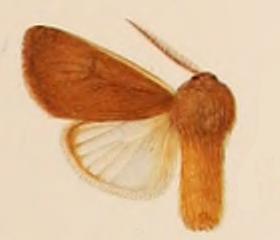Paracles is a genus of moths in the subfamily Arctiinae. The genus was described by Francis Walker in 1855. The species range from Panama to Patagonia, with quite a few in the southern temperate region of South America.

Paracles felderi is a moth of the subfamily Arctiinae first described by Rothschild in 1910. It is found in Brazil.
Paracles amarga is a moth of the subfamily Arctiinae first described by Schaus in 1933. It is found in Argentina.

Paracles azollae is a moth of the subfamily Arctiinae first described by Berg in 1877. It is found in Argentina.

Paracles costata is a moth of the subfamily Arctiinae first described by Hermann Burmeister in 1878. It is found in Brazil.
Paracles contraria is a moth of the subfamily Arctiinae first described by Francis Walker in 1855. It is found in the Amazon rainforest of Brazil, French Guiana and Bolivia.
Paracles flavescens is a moth of the subfamily Arctiinae first described by Schaus in 1896. It is found in Brazil.

Paracles severa is a moth of the subfamily Arctiinae first described by Carlos Berg in 1875. It is found in Argentina.

Paracles tenuis is a moth of the subfamily Arctiinae first described by Carlos Berg in 1877. It is found in Argentina, Uruguay and Colombia.
Paracles quadrata is a moth of the subfamily Arctiinae first described by Rothschild in 1910. It is found in Paraguay.

Paracles deseticola is a moth of the subfamily Arctiinae first described by Carlos Berg in 1875. It is found in Argentina and Patagonia.

Paracles burmeisteri is a moth of the subfamily Arctiinae first described by Berg in 1877. It is found in Argentina.
Paracles discalis is a moth of the subfamily Arctiinae first described by George Hampson in 1905. It is found in Paraguay.
Paracles fulvicollis is a moth of the subfamily Arctiinae first described by George Hampson in 1905. It is found in Chile. There are several species in the southern temperate region of South America, from Panama to Patagonia.

Paracles fusca is a moth of the subfamily Arctiinae first described by Francis Walker in 1856. It is found in Brazil and Argentina.
Paracles insipida is a moth of the subfamily Arctiinae first described by Rothschild in 1910. It is found in Argentina.
Paracles ockendeni is a moth of the subfamily Arctiinae first described by Rothschild in 1910. It is found in Peru.
Paracles sericea is a moth of the subfamily Arctiinae first described by Schaus in 1896. It is found in Brazil.

Leucanopsis infucata is a moth of the family Erebidae. It was described by Carlos Berg in 1882 and is found in Argentina.

Paracles argentina is a moth of the subfamily Arctiinae first described by Carlos Berg in 1877. It is found in Corrientes Province, Argentina.









